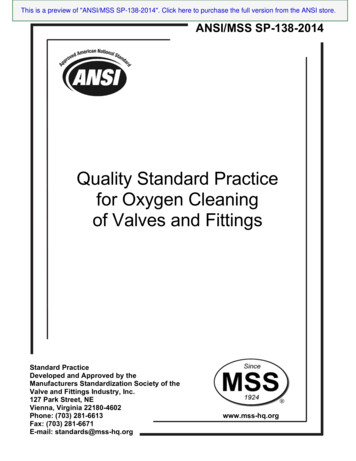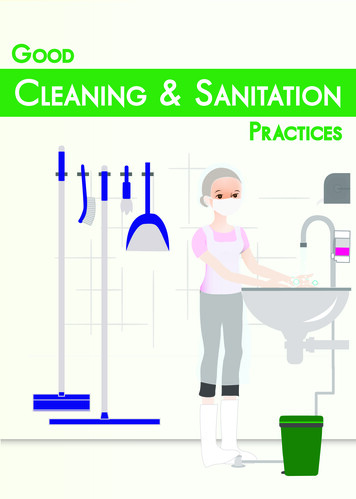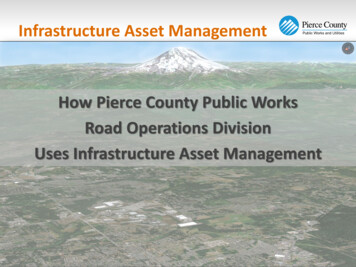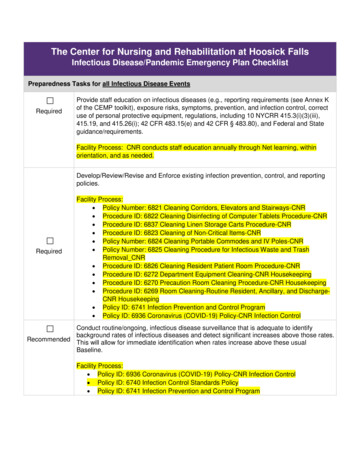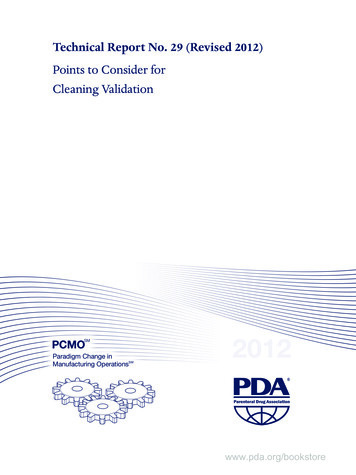
Transcription
Technical Report No. 29 (Revised 2012)Points to Consider forCleaning ValidationParadigm Change inManufacturing OperationsSMBethesda Towers4350 East West HighwaySuite 200www.pda.org/bookstoreBethesda,MD 20814 USATel: 1 (301) 656-5900
PDA Task Force on Technical Report No. 29 (Revised 2012):Points to Consider for Cleaning ValidationAuthorsDestin A. LeBlanc, Cleaning Validation Technologies(Chair)Gretchen Allison, PfizerJennifer L. Carlson, GenentechJamie Osborne, Siegfried (USA), Inc.Greg Randall, Baxter BiosciencePierre-Michel Riss, Eli LillyKoshy George, ConsultantGeorge Verghese, STERIS CorporationIgor Gorsky, ConcordiaValSourceJenn Walsh, Bristol-Myers SquibbIrwin S. Hirsh, Novo Nordisk ASVivienne Yankah, Sanofi-Pasteur, Ltd.The content and views expressed in this Technical Report are the result of a consensus achieved by the authorizingTask Force and are not necessarily views of the organizations they represent.www.pda.org/bookstore
Points to Consider forCleaning ValidationTechnical Report No. 29 (Revised 2012)ISBN: 978-0-939459-48-3 2012 Parenteral Drug Association, Inc.All rights reserved.Bethesda Towers4350 East West HighwaySuite 200Bethesda, MD 20814 USATel: 1 (301) 656-5900Fax: 1 (301) 986-0296E-mail: info@pda.orgWeb site: www.pda.orgwww.pda.org/bookstore
Paradigm Change in Manufacturing Operations (PCMOSM)PDA launched the project activities related to the PCMO program in December 2008 to help implement the scientific application of the ICH Q8, Q9 and Q10 series. The PDA Board of Directors approved this program in cooperation with the Regulatory Affairs and Quality Advisory Board, and theBiotechnology Advisory Board and Science Advisory Board of PDA.Although there are a number of acceptable pathways to address this concept, the PCMO program follows and covers the drug product lifecycle, employing the strategic theme of process robustness within the framework of the manufacturing operations. This project focuses on Pharmaceutical QualitySystems as an enabler of Quality Risk Management and Knowledge Management.Using the Parenteral Drug Association’s (PDA) membership expertise, the goal of the ParadigmChange in Manufacturing Operations Project is to drive the establishment of ‘best practice’ documents and /or training events in order to assist pharmaceutical manufacturers of InvestigationalMedicinal Products (IMPs) and commercial products in implementing the ICH guidelines on Pharmaceutical Development (ICH Q8, Q11), Quality Risk Management (ICH Q9) and PharmaceuticalQuality Systems (ICH Q10).The PCMO program facilitates communication among the experts from industry, university and regulators as well as experts from the respective ICH Expert Working Groups and Implementation WorkingGroup. PCMO task force members also contribute to PDA conferences and workshops on the subject.PCMO follows the product lifecycle concept and has the following strategic intent: Enable an innovative environment for continual improvement of products and systems Integrate science and technology into manufacturing practice Enhance manufacturing process robustness, risk based decision making and knowledge management Foster communication among industry and regulatory authoritiesThe Product Life mmercialManufacturingProductDiscontinuationFor more information, including the PCMO Dossier, and to get involved, go towww.pda.org/pcmowww.pda.org/bookstore
Table of Contents1.0 Introduction.11.1 Purpose/Scope. 12.0 Glossary of Terms.32.1 Definition of Acronyms. 53.0 Cleaning Process Design and Development.73.1 Cleaning Process Design. 73.2 Cleaning Process Overview. 83.2.1 Physical-chemical Aspects . 93.3 Design Considerations. 103.3.1 Location of Cleaning. 103.3.1.1 In-Place Cleaning. 103.3.1.1.1 Clean-in-Place (CIP) Systems. 103.3.1.1.2 Solvent Reflux Cleaning. 113.3.1.1.3 Placebo Batches as aCleaning Method. 113.3.1.2 Out-of-Place Cleaning. 113.3.1.2.1 Clean-Out-of-Place Systems. 123.3.2 Automated vs. Manual Systems. 123.3.2.1 Manual Processes. 123.3.2.2 Semi-Automated Processes. 123.3.2.3 Automated Processes. 133.3.3 Soil Evaluation and Categorization. 133.3.3.1 Soil Categories. 133.3.3.2 Soil Removal. 133.3.4 Equipment Considerations. 143.3.4.1 Dedicated – NondedicatedManufacturing Equipment. 143.3.4.2 Nonproduct Contact – ProductContact Surfaces. 153.3.4.3 Low-Risk Sites – High-Risk Sites. 153.3.4.4 Materials of Construction. 153.3.5 Operational Considerations. 153.3.6 Cleaning Agent Selection. 163.3.7 Product Considerations. 163.3.7.1 Product Risk Considerations. 173.4 Cleaning DevelopmentLaboratory Experiments . 173.4.1 Soil Selection . 173.4.2 Parameter Selection. 183.4.2.1 Parameter Interactions . 193.4.3 Measurements to DetermineCleaning Effectiveness. 193.5 Cleaning Process Scale-Up. 193.5.1 Setting Process Controls. 193.6 Applying the “Design Space” Concept toCleaning Processes . 203.7 Standard Operating Procedures. 213.8 Operator Training for the Cleaning Process. 213.9 Introduction of New Products to aValidated Cleaning System. 224.0 Qualification.234.1 Protocol Elements. 234.2 Key Protocol Issues . 234.2.1 Number of Runs in a Protocol. 244.2.2 Mock Soiling. 244.2.3 Worst-Case Process Conditions. 244.2.4 Disposition of Products and Equipmentduring Validation. 254.3 Grouping/Family Approach. 254.3.1 Product Grouping. 264.3.2 Equipment Grouping. 264.3.3 Introduction of a New Product orEquipment into a Group. 274.4 “Cleaning Verification” Documentation. 275.0 Residue and Limits.295.1 Considerations for Developing Limits. 295.2 The Basis for Quantitative Limits. 305.3 Acceptable Concentration of Residue inNext Product. 305.3.1 ARL Based on Drug Active Dose. 305.3.2 ARL Based on Toxicity. 315.3.2.1 ADE Determinations Based on ISPE’sRisk-MaPP. 315.3.2.2 Toxicity Calculations Basedon LD50 Data. 325.3.3 Other ARL Determinations. 335.4 Acceptable Total Carryover. 335.5 Surface Area Limit. 345.6 Limit in Protocol Samples. 345.6.1 Limit per Swab. 345.6.2 Concentration Limit inExtracted Swab Solvent. 345.6.3 Concentration Limit inRinse Sampling Solution. 355.7 Consolidated Expressions. 355.8 Example Calculations. 365.9 Other Considerations. 365.9.1 Multiple Next Products. 365.9.2 Next Product in VerificationApproach. 375.9.3 Default Limits. 37www.pda.org/bookstore
5.9.4 Use of Different Safety Factors. 385.9.5 Different Routes of Administration. 385.9.6 Different Doses forAdults and Children. 385.9.7 Human and VeterinaryProducts Manufactured on theSame Equipment. 385.9.8 Residues of Genotoxic and Other HighlyHazardous Active Ingredients. 385.9.9 Limits Based on AnalyticalDetection Limits. 395.9.10 Degradation of the Active Ingredient. 395.9.11 Limits Not Measureable. 395.9.12 Limits for Organic Solvents. 395.9.13 Dedicated Equipment . 405.9.14 Dividing a Limit among VariousPieces of Equipment. 405.9.15 .Limits for Preferential Transfer to a FirstPortion of the Next Product. 405.9.16 Limits for BiotechnologyManufacture. 405.9.17 Products with More Than One ActiveIngredient. 415.105.115.12Bioburden Limits. 41Endotoxin Limits. 42Visually Clean Criterion . 426.0 Sampling.436.1 Sampling Method Selection. 436.1.1 Direct Sampling Methods. 436.1.1.1 Visual Inspection. 436.1.1.2 Instrumental Methods. 446.1.2 Rinse Sampling. 446.1.2.1 Extraction Rinse Sampling for SmallParts. 466.1.2.2 Solvent Reflux Sampling. 466.1.3 Swab and Wipe Sampling. 466.2 Placebo Sampling. 476.3 Sampling for Microbial andEndotoxin Analysis. 476.4 Additional Considerations. 486.5 Sampling Recovery Studies. 486.5.1 General Considerations. 486.5.2 Swab/Wipe Recovery. 496.5.3 Rinse Recovery. 506.5.4 “Recovery” in Visual Inspection. 516.5.5 Recovery for Bioburden andEndotoxin Sampling. 516.6 Training and Qualification of Samplers. 516.6.1 Key Issues for Trainingfor Swab Sampling. 526.6.2 Key Issues for Training for RinseSampling. 526.6.3 Training for Visual Inspection. 527.0 Analytical Methods.547.1 Purposes of the Analytical Methods. 547.2 Practical Considerations in Selecting AnalyticalMethods. 547.3 Specific vs. Nonspecific Analytical Methods forValidation Protocols. 557.3.1Regulatory Status of Specific andNonspecific Methods. 557.4 Most Commonly Used Analytical Techniques.567.4.1 Liquid Chromatography (LC). 567.4.2 UltraViolet/Visible Spectrophotometry(UV/Vis). 577.4.3 Total Organic Carbon (TOC). 577.4.4 Conductivity. 577.4.5 Organoleptic Evaluation. 587.5 Other Useful Analytical Techniques. 597.5.1 pH. 597.5.2 InfraRed (IR). 597.5.3 Light Microscopy. 597.5.4 Titrations. 597.5.5 Gravimetric Analysis. 597.5.6 Enzyme Linked ImmunosorbantAssay (ELISA). 607.5.7 Capillary Zone Electrophoresis (CZE).607.5.8 Atomic Absorption (AA) andInductively Coupled Plasma (ICP). 607.5.9 Ion Mobility Spectrometry (IMS). 607.6 Microbial Test Methods. 607.6.1 Endotoxin. 607.6.2 Bioburden. 607.7 Analytical Method Validation. 617.7.1 General Principles. 617.7.2 Compendial Methods. 627.7.3 Visual Inspection. 637.7.4 Bioburden Methods. 637.7.5 Transfer to another Laboratory andUse of Contract Laboratories. 638.0 Maintenance of Validated State.648.1 Critical Parameter Measurement. 648.2 Process Alarms. 648.3 Change Control. 65www.pda.org/bookstore
8.48.58.68.78.8Routine Monitoring. 66Data Trending and Review. 66Evaluation of Cumulative Changes. 67Training. 67Periodic Review. 679.0 Documentation.699.1 Cleaning Validation Master Plans. 699.1.1 Elements of a Comprehensive Plan. 709.1.2 Harmonization of Site CleaningValidation Programs . 719.29.39.49.5Documentation for Design/Development. 71Documentation for Qualification. 72Documentation for Validation Maintenance. 72Other Documentation Considerations. 7310.0 Special Considerations.7510.1Cleaning Agents. 7510.1.1 Types. 7510.1.1.1 Water. 7510.1.1.2 Organic Solvents. 7510.1.1.3 Commodity Alkali. 7510.1.1.4 Commodity Acids. 7510.1.1.5 Formulated Detergents. 7510.1.2 Factors in Selection. 7610.1.2.1 Broad Spectrum Effectiveness. 7610.1.2.2 Substrate Compatibility. 7610.1.2.3 Stability and Shelf Life. 7610.1.2.4 Analyzability. 7610.1.2.5 Disposal. 7610.1.2.6 Safety. 7610.1.2.7 Toxicity. 7610.1.2.8 Rinsability. 7610.1.2.9 Quality. 7610.2Nonproduct Contact Surfaces. 7610.3Process Analytical Technology. 7710.3.1 Timely Measurements. 7710.3.2 PAT for Cleaning Process Control. 7710.3.3 Additional Considerations for OnlineMeasurements. 7810.4Clean Hold Considerations. 7810.5New and Used Equipment. 8010.5.1 New Equipment. 8010.5.1.1 Cleaning Procedure Development. 8010.5.1.2 Post-Installation Cleaning. 8110.5.1.3 Grouping Impact. 8110.5.1.4 Limit Calculation Impact. 8110.5.2 Used Equipment. 8110.6Measurement Systems Analysis (MSA) .8110.6.1 MSA Components. 8210.6.2 Attribute R&R. 8210.6.3 Minimizing Variations. 8210.6.4 MSA and CleaningValidation Strategy. 8210.7Cleaning for API Manufacture. 8310.8Topical Drug Products. 8410.8.1 Topical Drug Products withSystemic Availability. 8410.8.2 Topical Drug Products with No orLimited Systemic Availability. 8510.8.2.1 Adjusted Calculation. 8510.8.2.2 Modification Based onFrequency of Application. 8510.8.2.3 Modification Based on AmountApplied per Surface Area. 8510.8.2.4 Additional Considerations. 8610.8.3 Additional Safety Considerations. 8610.8.4 Additional Cleaning Considerations. 8610.9Animal Drug Products. 8610.10 Packaging Components andPackaging Equipment. 8610.10.1 Primary Packaging Components. 8610.10.1.1 Oral Dosage Forms PrimaryPackaging Components. 8710.10.1.2 Parenteral Dosage Forms PrimaryPackaging Components. 8710.10.2 Packaging Equipment. 8710.10.2.1 Primary Packaging Equipment. 8710.10.2.2 Secondary Packaging Equipment. 8810.11 Tubing and Hoses. 8810.12 Excipients. 8910.13 Dedicated Equipment. 8910.13.1 Reasons for Dedication. 8910.13.2 Cleaning Validation Issues. 9011.0 Regulatory and Guidance Documents.9112.0 References.9213.0 Suggested Readings.94www.pda.org/bookstore
FIGURES AND TABLES INDEXTable 3.1-1 CPP and CQA Considerations thathave Potential Risk Impact to aCleaning Process. 7Table 3.1-2 The Cleaning Spectrum. 8Table 3.2-1Cleaning Process Steps (Examples). 9Table 6.1.2-1 Comparison of Grab Sampling versusSeparate Sampling Rinse. 45Table 6.1.2-2Table 6.1.3-1Figure 9.5-1Advantages and Limitationsof Rinse Sampling. 45Advantages and Limitationsof Swab/Wipe Sampling. 47Documentation for Process Flow. 74www.pda.org/bookstore
1.0 IntroductionCleaning validation plays an important role in reducing the possibility of product contamination frompharmaceutical manufacturing equipment. It demonstrates that the cleaning process adequately andconsistently removes product residues, process residues and environmental contaminants from themanufacturing equipment/system, so that this equipment/system can be safely used for the manufacture of specified subsequent products (which may be the same or a different product). As used inthis Technical Report, “product” may be a drug product, active pharmaceutical ingredient, intermediate, or another type of formulation. If “drug product” is intended, that terminology will be utilized.Principles and practices given in this report may apply to a variety of manufacturing situations. It isincumbent on the reader to decide the appropriateness of those principles and practices to his/herspecific situation.This report builds on the 1998 PDA Technical Report No. 29, Points to Consider for Cleaning Validation (1).This report also has utilized principles and specific wording from the 2010 PDA Technical Report No. 49,Points to Consider for Biotechnology Cleaning Validation (2). The authors of this revised Technical Report#29 would like to thank the members of the Task Forces who were responsible for those two earlierdocuments for making our job easier.This revised Technical Report presents updated information that is aligned with lifecycle approachesto validation and the International Conference on Harmonisation (ICH) guidelines Q8 (R2) - Pharmaceutical Development, Q9 - Quality Risk Management and Q10 - Pharmaceutical Quality System (3,4,5).Also, this report aims to assist readers who want to create or benchmark a cleaning validation program for their equipment and facilities.This Task Force was composed of European and North American professionals from pharmaceuticalmanufacturers, cleaning chemical suppliers, and consulting companies. The report has undergone aglobal, technical peer review to ensure concepts, terminology, and practices presented are reflectiveof sound science and can be used globally.1.1Purpose/ScopeThis Technical Report covers all facets of cleaning validation for pharmaceutical manufacturers, including both manufacturers of APIs and drug products. It also applies to biotechnology manufacturing; however, the reader should consult PDA Technical Report No. 49, Points to Consider for BiotechnologyCleaning Validation for more detail and specifics for biotechnology manufacturing (2). We have included a lifecycle cleaning validation approach, including design/development of the cleaning process,process qualification (including the protocol runs), and ongoing validation maintenance. While thedocument discusses risk-based approaches, it does not provide details about risk-based manufacturing. PDA has formed a Task Force to write a Technical Report on that topic.We cannot emphasize enough how important risk analyses are in the selection of and validation ofcleaning processes and their validation. This includes the traditional risk analysis based on effects onproduct quality and on patients. It also includes business risk considerations, such as steps taken tominimize lost product from contamination (even if detection systems are in place to prevent releaseof that contaminated product for consumer use).These practices and the associated guidance in this Technical Report are based on technical considerations and should be applicable in all regulatory environments. However, the intent of this TechnicalReport is not to provide a detailed plan or roadmap for a pharmaceutical manufacturer to performcleaning validation. Rather, as the title suggests, it presents “points to consider” as one designs a cleaning validation program for process equipment based on an understanding of one’s manufacturingand cleaning processes. In cleaning validation, there are generally multiple ways to accomplish theTechnical Report No. 29 (Revised) www.pda.org/bookstore 2012 Parenteral Drug Association, Inc.1
same goal of a compliant, scientifically sound and practical cleaning validation program. Where options are given, the rationales for such options are also generally given. Examples are not meant to beprescriptive or limiting; they merely illustrate a certain practice. Actual acceptable practices shouldnot be considered limited by the discussion in this Technical Report. Based on an understanding ofthe unique nature of any individual situation, different approaches or additional issues should also beconsidered. Sound science based on an understanding of the cleaning and manufacturing processesmay lead to other equally acceptable practices. The Task Force that developed this document hopesthat the report will be used in this spirit and will not be solely used as a checklist.This report should be considered to be a resource to help guide the development or evaluation of acleaning validation program. It is not intended to establish mandatory standards for cleaning validation. It is intended to be a single-source overview for pharmaceutical manufacturers that complements existing regulatory guidance and other documents referenced in this document. The readershould also be aware that a specific topic may be discussed in several sections of this Technical Report.Therefore, a more complete perspective may be obtained by considering all relevant sections about acertain topic. Furthermore, while many approaches are presented here, specific approaches utilizedfor a given cleaning process should be selected based on a good understanding of that process, as wellas the appropriateness of the selected practice for that specific situation. It is not enough to merely saythat the practice is mentioned as an acceptable one in PDA Technical Report No. 29; each firm shouldbe prepared to defend why the selected approach is a valid one for its operations (1).2 2012 Parenteral Drug Association, Inc. www.pda.org/bookstoreTechnical Report No. 29 (Revised)
Bethesda Towers 4350 East West Highway Suite 200 Bethesda, MD 20814 USA Tel: 1 (301) 656-5900 Fax: 1 (301) 986-0296 E-mail: info@pda.org Web site: www.pda.org








